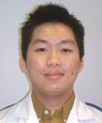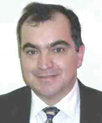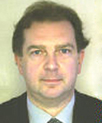The Rotating Cylinder Electrode (RCE) and its Application to the Electrodeposition of Metals*
C. T. John Low A , Carlos Ponce de Leon A and Frank C. Walsh AA Surface and Electrochemical Engineering Groups, School of Engineering Sciences, University of Southampton, Southampton SO17 1BJ, UK.
B Corresponding author. Email: F.C.Walsh@soton.ac.uk

Chee Tong John Low was born in 1980 in Kuala Lumpur. He studied at Taylor's College, Malaysia, then obtained a B.Eng. degree at the University of Bath, UK (2003). His current Ph.D. programme, supervised by Frank Walsh, involves current distribution, mass transport, and metal deposition at rotating cylinder electrodes. His research interests include alloy deposition, surface finishing of metals, nanoparticle inclusions in to deposits, and computer modelling of current distribution. |

Carlos Ponce de Leon holds a B.Sc. and an M.Sc. in chemistry from the Autonomous Metropolitan University, Mexico, and a Ph.D. in electrochemistry/electrochemical engineering from the University of Southampton (1995). He has extensive industrial experience in quality control (Schering/Proquina), data acquisition and fuel cells (Mexican Petroleum Institute), and analytical chemistry (Ciba Geigy). His research interests include electrochemical techniques, metal ion removal, characterization of novel electrode materials, electrochemical strategies for pollution control, and redox flow cells for energy conversion, resulting in over 20 scientific papers. He holds the post of Research Fellow in the Research Institute for Industry at the University of Southampton. |

Frank Walsh holds a B.Sc. in applied chemistry (Portsmouth Polytechnic, 1975), M.Sc. in materials protection (UMIST/ Loughborough University, 1976), and a Ph.D. in electrodeposition in rotating cylinder electrode reactors (Loughborough University, 1981). He is the author of over 200 papers and three books in the areas of electrochemistry and electrochemical engineering. He is a chartered and registered European engineer, an international consultant and leads a research group in electrochemical engineering. Currently, he is Professor in Electrochemical Engineering at the University of Southampton and takes a particular interest in the training of students and industrial engineers in the areas of energy conversion and surface engineering. |
Australian Journal of Chemistry 58(4) 246-262 https://doi.org/10.1071/CH05034
Submitted: 26 January 2005 Accepted: 1 March 2005 Published: 5 April 2005
Abstract
The application of rotating cylinder electrodes (RCEs) to electrodeposition has progressed significantly over the last decade. New tools for theoretical and experimental investigations have been developed in academia and in industry, with some RCE devices being commercially developed. This paper reviews the continued application of RCEs to quantitative electrodeposition studies of single metals, alloys, and composite, multilayered, and nanostructured electrodeposits with a constant or controlled range of current densities along the RCE under turbulent flow conditions. Rotating cylinder electrode electrochemical reactors, enhanced mass transport, rotating cylinder Hull cell, and uniform and non-uniform current and potential distributions are considered. The applications of ultrasound, porous reticulated vitreous carbon cathodes, expanded metal/baffles, and jet flow around the RCE are also included. The effects of electrolyte flow and cathode current density on electrodeposition have been rationalized. Directions for future RCE studies are proposed.
Acknowledgements
The authors are grateful to Windsor Scientific Ltd and Dr Keith Dawes for provision of RCH hardware and information. Dr Richard Wills provided helpful comments. F.C.W. is grateful to Prof. D. R. Gabe, Dr. F. S. Holland, and Ir. K. Helle for his early introduction to RCE technology. Thanks are due to Prof. J. M. Bisang (PRELINE, UNL, Argentina) for making an early version of ref. [28] available during the preparation of this review.
[1]
D. R. Gabe,
J. Appl. Electrochem. 1974, 4, 91.
| Crossref | GoogleScholarGoogle Scholar |
| Crossref | GoogleScholarGoogle Scholar |
| Crossref | GoogleScholarGoogle Scholar |
| Crossref | GoogleScholarGoogle Scholar |
| Crossref | GoogleScholarGoogle Scholar |
| Crossref | GoogleScholarGoogle Scholar |
| Crossref | GoogleScholarGoogle Scholar |
| Crossref | GoogleScholarGoogle Scholar |
in press.
| Crossref | GoogleScholarGoogle Scholar |
| Crossref | GoogleScholarGoogle Scholar |
| Crossref | GoogleScholarGoogle Scholar |
| Crossref | GoogleScholarGoogle Scholar |
| Crossref | GoogleScholarGoogle Scholar |
| Crossref | GoogleScholarGoogle Scholar |
| Crossref | GoogleScholarGoogle Scholar |
| Crossref | GoogleScholarGoogle Scholar |
unpublished.
| Crossref | GoogleScholarGoogle Scholar |
| Crossref | GoogleScholarGoogle Scholar |
| Crossref | GoogleScholarGoogle Scholar |
| Crossref | GoogleScholarGoogle Scholar |
| Crossref | GoogleScholarGoogle Scholar |
| Crossref | GoogleScholarGoogle Scholar |
| Crossref | GoogleScholarGoogle Scholar |
| Crossref | GoogleScholarGoogle Scholar |
| Crossref | GoogleScholarGoogle Scholar |
| Crossref | GoogleScholarGoogle Scholar |
| Crossref | GoogleScholarGoogle Scholar |
| Crossref | GoogleScholarGoogle Scholar |
| Crossref | GoogleScholarGoogle Scholar |
| Crossref | GoogleScholarGoogle Scholar |
| Crossref | GoogleScholarGoogle Scholar |
| Crossref | GoogleScholarGoogle Scholar |
| Crossref | GoogleScholarGoogle Scholar |
| Crossref | GoogleScholarGoogle Scholar |
| Crossref | GoogleScholarGoogle Scholar |
| Crossref | GoogleScholarGoogle Scholar |
| Crossref | GoogleScholarGoogle Scholar |
| Crossref | GoogleScholarGoogle Scholar |
| Crossref | GoogleScholarGoogle Scholar |
| Crossref | GoogleScholarGoogle Scholar |
| Crossref | GoogleScholarGoogle Scholar |
| Crossref | GoogleScholarGoogle Scholar |
| Crossref | GoogleScholarGoogle Scholar |
| Crossref | GoogleScholarGoogle Scholar |
| Crossref | GoogleScholarGoogle Scholar |
| Crossref | GoogleScholarGoogle Scholar |

* Parts of this paper were presented as a keynote address by F.C. Walsh at the 12th Australasian Electrochemistry Conference (12AEC), 4–8 July 2004, Gold Coast, Australia.


